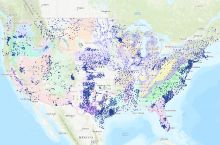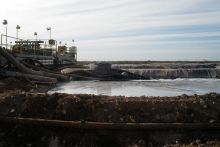Groundwater is the water found underground in the cracks and spaces in soil, sand, and rock. Groundwater has been used by humans for thousands of years; today it provides 25% of the fresh water used in the United States, mostly for irrigation and public water supplies.
Basics
Groundwater is an inevitable result of gravity: if surface water can seep into the ground before it evaporates or flows away, it will. Water also flows through rocks underground and may flow out of the ground into streams, rivers, lakes, or the ocean in places where the land surface is lower than the water table (e.g., at the bottom of a valley or the side of a cliff) – these outflows of groundwater are commonly called “springs”. In this way, surface water and groundwater are intimately linked – in some places, changes in groundwater levels can have major effects on the levels of nearby rivers and lakes, and vice versa. Read more
Frequently Asked Questions
Do you have a question that's not listed here? Search all FAQs
Explore Related Topics
Since 1980 the United States has experienced more than 24 major droughts, resulting in almost 3,000 deaths and economic impacts exceeding $225 billion. All areas of the U.S. have some drought risk.
Geothermal energy is harvested by drilling into underground reservoirs of steam or water heated by the Earth. While western states like California and Nevada lead the country in geothermal energy production, emerging technologies may make it possible to extract geothermal energy throughout the United States.
Sinkholes have both natural and artificial causes. They tend to occur most often in places where water can dissolve the bedrock (especially limestone) below the surface, causing overlying rocks to collapse. Florida, Texas, Alabama, Missouri, Kentucky, Tennessee, and Pennsylvania are most sinkhole-prone.
Water is essential for society and, as demand steadily rises, our most precious commodity. Geoscientists study how to provide a clean and secure water source to meet society's needs.
Water is constantly moving on the Earth between the atmosphere, ocean, rivers and streams, snowpacks and ice sheets, and underground. Water availability, both as surface water and groundwater, is essential for agriculture, human consumption, industry, and energy generation.
Water quality refers to whether water is suitable for a certain purpose, like drinking or irrigation. Both natural and man-made factors can affect water quality. Contaminants can include bacteria, metals, and man-made chemicals like pesticides or pharmaceutical drugs.

























